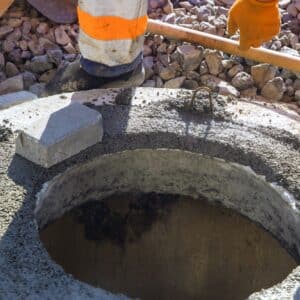Confined spaces—like tanks, manholes, silos, and pipelines—pose serious risks due to limited airflow, restricted entry/exit, and the potential buildup of toxic gases. In Canada, these environments have contributed to numerous workplace injuries and fatalities, often because the hazards weren’t properly recognized or managed. Understanding the risks and implementing effective controls is crucial for protecting workers in these high-risk spaces.
What Is a Confined Space?
Under Canadian regulations, a confined space is defined as an enclosed or partially enclosed area that:
- Is not designed for continuous human occupancy,
- Has limited means of entry or exit,
- May contain hazardous atmospheric conditions or other safety risks.
Examples include tanks, sewers, crawl spaces, vats, and ductwork.
The Hidden Threat: Air Quality

Common atmospheric hazards include:
- Low oxygen levels (below 19.5%), which can lead to dizziness, unconsciousness, or death,
- Oxygen enrichment (above 23%), increasing the risk of fire or explosion,
- Toxic gases like hydrogen sulfide (H₂S), carbon monoxide (CO), and methane,
- Flammable vapours or airborne particulates such as combustible dust.
According to data from the Canadian Centre for Occupational Health and Safety (CCOHS), atmospheric hazards are among the leading causes of confined space fatalities.
Real-World Example
A 2016 incident in British Columbia led to the deaths of two workers inside a confined space due to hydrogen sulfide exposure—a stark reminder of the consequences of inadequate air monitoring and safety procedures.
Regulatory Framework in Canada
Across Canada, confined space regulations vary slightly by province but are generally aligned with federal guidelines under Canada Occupational Health and Safety Regulations (COHSR), Part XI.
For example:
- In Ontario, Regulation 632/05 governs confined space entry,
- In Alberta, confined space safety is addressed in Part 5 of the OHS Code,
- CSA Standard Z1006-16 provides national guidance on managing work in confined spaces.
These regulations typically require:
- Hazard assessments,
- Entry permits,
- Atmospheric testing,
- Rescue procedures,
- Worker training.
Steps to Ensure Safety in Confined Spaces
To prevent incidents, employers must establish a comprehensive confined space safety program. Key components include:
- Identify and Assess Confined Spaces
Start by conducting a hazard assessment to determine which spaces are confined and whether they pose atmospheric or physical risks.
- Air Monitoring
Before entry, test the air using a calibrated gas detector to check:
- Oxygen concentration,
- Flammable gases and vapours,
- Specific toxic substances (e.g., H₂S, CO).
Continuous monitoring should be in place while workers are inside.
- Ventilation
Use mechanical ventilation (e.g., air movers or blowers) to eliminate or control hazardous atmospheres. This is especially important during tasks like welding, painting, or cleaning.
- Permit System
Most provinces require a written entry permit outlining:
- Hazards present,
- Protective measures in place,
- Duration of entry,
- Names of authorized entrants and attendants.
- Training and Communication
All workers involved in confined space entry must be trained in:
- Hazard recognition,
- Emergency response,
- Proper use of PPE and monitoring equipment.
Communication between entrants and attendants is essential during the entire operation.
- Rescue Planning
Canadian regulations mandate a rescue plan for every confined space entry. This must include:
- A designated, trained rescue team,
- Appropriate rescue equipment (e.g., tripod and winch, SCBA),
- Regular practice drills.
Delayed or poorly executed rescue attempts have resulted in multiple fatalities in past incidents.
The Role of Industrial Hygienists

- Perform detailed hazard assessments,
- Recommend appropriate air monitoring strategies,
- Advise on ventilation and PPE,
- Ensure regulatory compliance.
Partnering with a qualified professional helps reduce risk and protect workers’ lives.
Final Thoughts
Confined spaces may look harmless, but they can be lethal without proper controls. In Canada, toxic air remains a significant hazard in these environments. By adhering to provincial OHS regulations, using reliable air monitoring, and ensuring workers are trained and prepared, employers can drastically reduce the risk of injury or death.
Reach out to our Team Today!
How Can We Help You?
Contact us at JADA Solutions (HSE) Inc. to speak with one of our professionals!
Newsletter
📹 Watch our latest Safety Toolbox Talk: Mould and Fungi 101: Viable vs. Non-Viable Mould Testing
💡Are all moulds considered fungi? And why should we care? This leads us to explaining the two different types of testing for mould exposure: viable vs non-viable.
🔍 Lead and Heavy Metal Exposure: Are You Protecting Your Workers?
Lead and other heavy metals can quietly put your team at serious risk - especially during construction, demolition, or manufacturing projects.
Our last Asbestos Worker in Alberta 2-Day Training Course before the Summer season happens at the end of this month!
🗓️ June 24th - 25th
⏰ 8AM - 5PM
💵 $525
📍 Sherwood Park, AB
Claim your spot now! 👉


